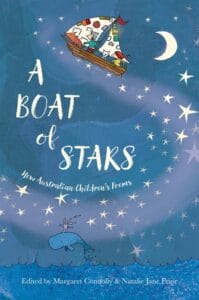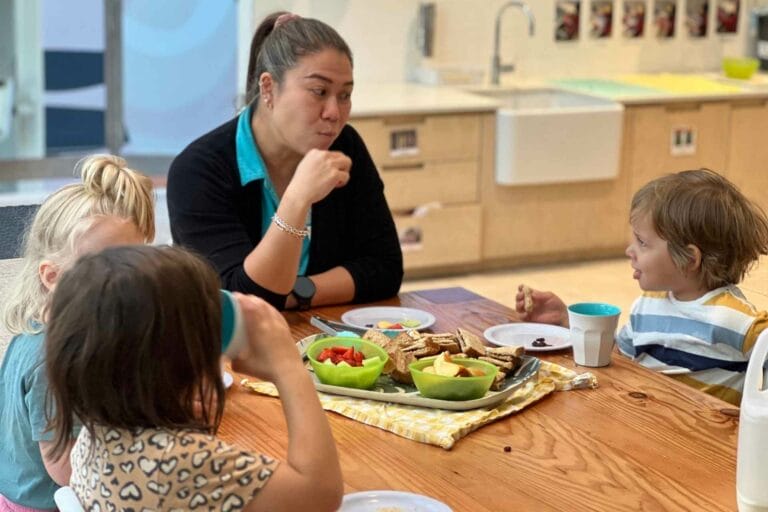What’s in a poem?

Young children love poems. A quality poem can “delight the ear, stimulate the mind, and touch the emotions” (Zeece, 1998, p. 102) of young children.
Happiness
John had Great Big Waterproof Boots on;
– by A.A.Milne
John had a Great BigWaterproof Hat;
John had a Great Big Waterproof
Mackintosh- And that (Said John) Is That.
A quality poem can be a simple one as the one above, a favourite of my preschool children when I was a full-time early childhood teacher. I believe this poem really did evoke happiness within them as they recited the poem off by heart and created their own actions.
Introducing children to a variety of poetry can be overlooked due to our busy lives and maybe lack of awareness of the many benefits for young children. August is National Poetry Month so let’s look at the benefits and ways we can encourage emergent poets within our children.
Why introduce children to poetry?
Poetry exposes children to different rhythms, sounds, vocabulary, language patterns and print. Some of the benefits include developing the children’s:
- literacy skills, vocabulary and language development,
- numeracy, music and movement skills,
- listening skills, concentration, and memory,
- imagination and creativity,
- emotional intelligence, eg: expanding their capacity to experience and understand emotions,
- social skills, eg: working together to create a poem,
- a love of language, and
- cultural awareness and connection.
Fun educational poetry experiences for children:
Read poems together
When read aloud, poetry is rhythmic and musical with different sounds and beats. Babies and young children may not understand all the words or meanings, but they will feel the rhythms and emotions and be curious about the language and meaning.
By reading poems together, children will begin to recognise and memorise patterns both audibly and visually. As with stories, children will ask for their favourite poems to be re-read. Encourage them to join in with the memorable words, phrases or repeated refrain. After they have familiarised themselves with hearing the words you may like to point to some of the words while reading the text, for example, the rhyming words. “Recognising the connection between written symbols and oral language helps prepare children to be ready to read and write” (AEDC, 2018a).
Beat out the rhythm or incorporate actions
Clapping or using percussion instruments is a great way for children to beat out the rhythm as poems are read together. Adding fun physical movement such as swaying, turning around, or acting out the words, can also help children begin to discern sounds, intonations, rhythm, and make meaningful connections to the words and language.
Create your own poems
“It took me four years to paint like Raphael, but a lifetime to paint like a child”
– (Pablo Picasso)
Children are naturally creative and have wonderfully active imaginations. Poetry is a great outlet for their creativity and can encourage them to play with different words and word patterns. It can vary from being a collective of favourite words to having more of a narrative structure.
Where do we start?
Emergent poetry is an interactional achievement where poetic aspects emerge in the interaction between the child and adult. Here are some tips from our Sydney Early Education Centres:
- Inspiration often starts with a picture, event, or a child’s drawing.
- Collectively decide to write a poem.
- Encourage the child/ren to describe what they see or have experienced from the inspiration.
- The teacher/adult writes the contributions down for all to see.
- The teacher/adult reads them out and asks the children if there is anything they would like to add or change. ‘Word-art’ is created by the teacher/adult, eg; the order of the words and taking out binding words such as ‘and then’ that is often absent in a poem.
- Attempts can be made to use tools (Vygotsky, 1978) to make the poetry more
poetic. For example, introducing repetition, or for older children, sound and
rhythm (onomatopoeia), or encouraging a simile or metaphor.
Remember, like any art-form, poetry is subjective. Make it a fun learning experience and enjoy the process with your child/ren.
Some poetry books our SEEC community are enjoying reading this month:
References and further reading:
- Australian Early Development Census. (2018a). Guide to language and cognitive skills
(school-based). - Community Child Care. (2011). Early Literacy and Numeracy- ACECQA
Pramling, N. (2009). Introducing poetry‐making in early years education. European Early
Childhood Education Research Journal, 17(3), 377-390. - Raising Children Network (Australia) Limited. (2022). Developing Literacy
- Early Childhood Australia. (2017). Supporting language development in the early years
- Zeece, P. (1998). Dancing Words: Poetry for Young Children. Early Childhood Education
Journal, 26(2), 101–. https://doi.org/10.1023/A:1022955313707
We hope that this article has encouraged you to read more poetry with your children. If you would like to find out more about our service, you can book a tour or send us a message.

Written By
Written by Margaret Wilson, SEEC Manager







